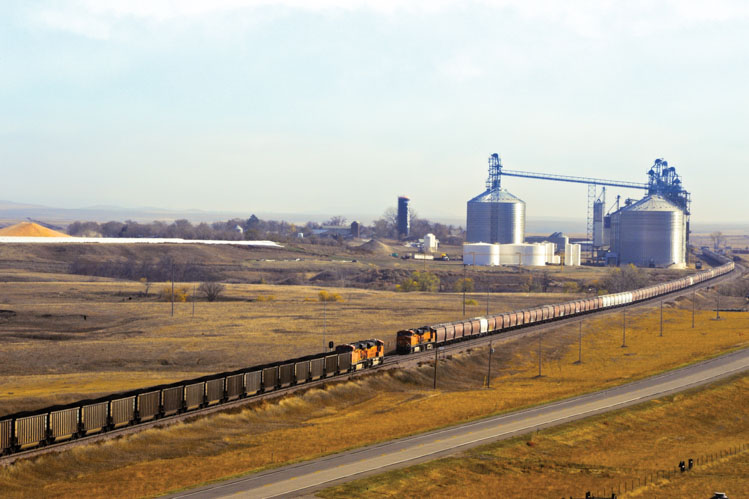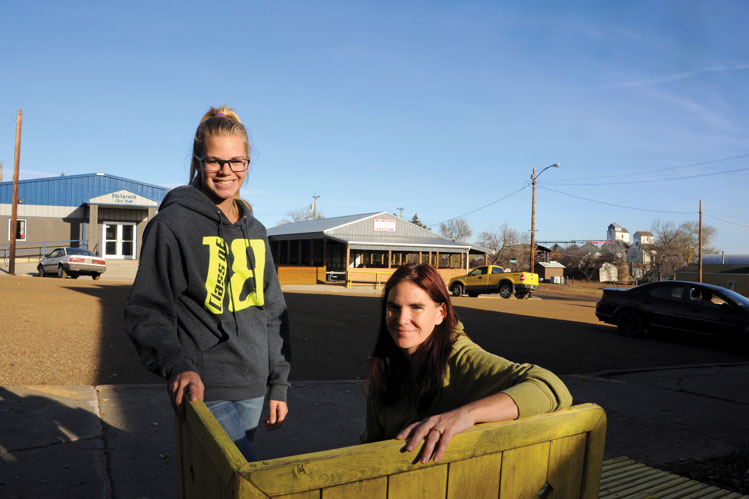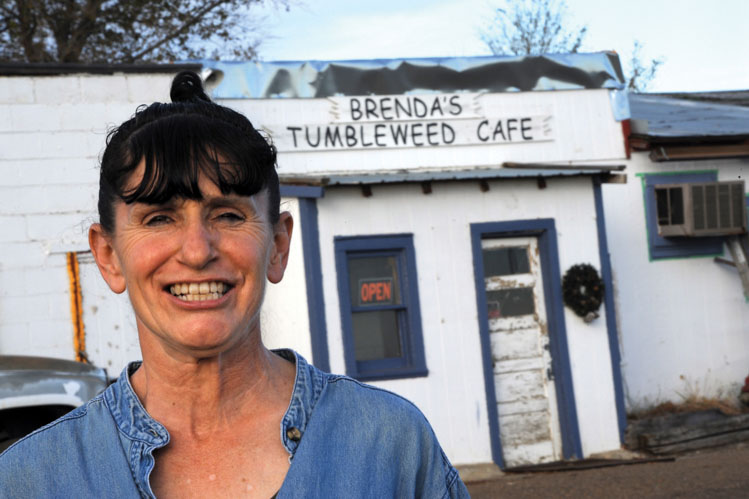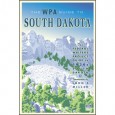The Gift of South Dakota
Subscriptions to South Dakota Magazine make great gifts!
Subscribe today — 1 year (6 issues) is just $29!
A Town Every 10 Miles
 |
| Trains still stop in McLaughlin, the largest town in Corson County, because the South Dakota Wheat Growers' grain elevator ships wheat, corn and soybeans by rail. |
McLaughlin’s cafe has a tribute to a local trucker who raised an amazing racehorse. The local sheriff, who lives at McIntosh, is famous for feeding 6,000 starving buffalo. The Merkels operate a new hotel in Watauga, pop. 29, just east of a tiny restaurant with brands burned on the walls.
South Dakota might have too many small towns, but which one would you close? Each has its own character and characters, and the 90-mile stretch of Highway 12 through Corson County — where there is or was a town every 8 or 10 miles — is classic.
“If it wouldn’t have been for the railroad, there wouldn’t be any towns,” says Ed Schock, a county commissioner who lives in McLaughlin, where he often helps his wife Sharon at the city library. “The steam engines needed to be filled with water every 10 miles or so, so that’s why we have so many little towns.”
Today, a dozen trains a day still string their way across a route that was created in 1909 and 1910, hugging the North Dakota/South Dakota border on the western half of Corson County. The steel rails parallel Highway 12 and pass through old towns planned by the railroaders.
McIntosh, the county seat, is named for two brothers who helped build the tracks. But most of the town names have roots in the region’s Native American heritage; in the Lakota language, Mahto (today a ghost town) means bear and Watauga means foaming water. Two-thirds of the county’s 4,100 residents are members of the Standing Rock Reservation, where many families trace their lineage to the great Sitting Bull who was killed there in 1890.
The towns of Walker and Morristown were named for cattle kings. McLaughlin got its name from a powerful Indian agent who was instrumental in developing the region. Geography was behind the naming of Keldron (someone’s spelling of cauldron) because a circle of hills and rounded buttes resembling a massive kettle surround the little village.
Corson County’s spacious grass prairies are beautifully punctuated by gentle buttes and hills shaped by glaciers a mere 20,000 or so years ago. They include Twin Buttes, Clay Butte, Hump Butte and Mud Butte. Black Horse Butte near the Grand River derives its name from a wild black stallion that led a band of mares before settlers arrived. Skull Butte, south of Morristown near the Moreau River, was the site of a bloody battle between the Sioux and the Crow; according to legend, 10 skulls rested on the white sandstone for years after the fight.
“Driving over this rolling countryside has reminded many travelers of floating over an ocean of grass,” wrote Hermosa author Linda Hasselstrom in her travel book, Roadside History of South Dakota. “The region’s buttes stand like lighthouses. Occasionally the highway drops abruptly into a valley with a stream, green grass and scampering wildlife … towns and homes seem unimportant in this place of sky touching earth.”
Yet there are towns and homes and people well spaced in a county that, geographically, is South Dakota’s fifth largest. The people are as varied and interesting as the buttes and river valleys.
 |
| Terri Baumeister (right) and her daughter, Megan, live in McIntosh, where citizens often enjoy Sunday morning brunches in the new City Hall. Baumeister, like many rural people, wears several hats: she is a deputy sheriff and the city finance officer. |
Keith Gall, sheriff for 25 years, has the easy-natured disposition of a Chamber of Commerce executive despite a host of challenges over the past few years. He and three deputies patrol the 2,500-square-mile county. They write three warning tickets for every actual traffic ticket (statistics like that are kept in a book in the courthouse hallway). They deal with everything from deer-car collisions to pet problems and a meth crisis. “Our problems were 95 percent alcohol related up to a few years ago and now it’s 90 percent drug related,” he says.
A few years ago, Sheriff Gall garnered national headlines when he and his deputies led an effort to feed 6,000 starving buffalo on the big Wilder ranch near McLaughlin. “We spent $60,000 on hay just the first week,” he recalls. He took charge of the animals for nearly three months, and saved most of them.
Another year someone abandoned 14 Chihuahuas. The lawmen spent days trying to trap the little dogs so Pets & Stuff in nearby Mobridge could find homes for them. “I’ve been bitten several times,” said Sheriff Gall, still smiling.
His good nature was sorely tested in 2006 when a young Texan named Dwight Crigger came to town with a grain combining crew and stayed to work as the Corson County Weed and Pest Supervisor. Crigger and the sheriff became friends when the Texan joined the volunteer fire department and ambulance service and became active in the community of McIntosh.
The sheriff found it odd when a county shop building burned down in late 2005, and he was greatly distressed when the county’s historic wood-frame courthouse went up in flames in April 2006. Suspicions arose when Crigger’s whereabouts became an issue, and after a 46-day investigation, the sheriff had to arrest his young friend for arson.
Fire, the enemy of many small towns, also destroyed the town’s city hall in 2010 and a popular bar and restaurant in 2014. But both the city hall and courthouse have been rebuilt. Motorists driving Highway 12 on a Sunday morning can get a taste of local flavor by stopping at the McIntosh City Hall, where school groups or community clubs almost always host a breakfast and lunch to raise funds for some local project.
Schock, the county commissioner and local historian, says Corson County has other interesting places for adventurous visitors to explore. He recommends an old church at Kenel with an unusual pulpit carved of local cottonwood. Sitting Bull’s home site, where he was killed in 1890, lies west of McLaughlin and the great chief’s grave is on the eastern edge of the county overlooking the Missouri River. The Lakota holy man was initially buried near Fort Yates, North Dakota. Relatives felt the burial site was not properly tended and tried legal means to return the remains to South Dakota. When all else failed, a group of Mobridge civic leaders and tribal members sneaked into North Dakota on a dark and snowy night in 1953. They dug up the rotted wood coffin, collected the bones and reburied them at the present location. Then they added 20 tons of concrete atop a new vault to discourage North Dakotans from planning a retaliatory raid.
Schock says the towns of McLaughlin and McIntosh once were bitter rivals, but today’s sparse population seems to have ameliorated the competition. “If you aren’t agriculture-minded, you don’t have much of a chance to make a living here today,” he says. “And it’s tough if you are in agriculture, too.”
 |
| Brenda Carroll reopened a cafe in Watauga that had housed a museum famous for a collection of cowboy memorabilia. |
A once-fierce rivalry between the McLaughlin High School Midgets and the McIntosh Tigers has diminished, and now the Midgets have succumbed to political correctness. The moniker dated to 1916 when nearby Wakpala had a tall basketball team and McLaughlin had some “smaller Roosian boys,” as the legend goes. The editor of the local paper referred to his team as the Midgets and it stuck until last year, when the local school board bent to pressure from the Little People of America to find a new mascot. They settled on the Mustangs.
McLaughlin never won a basketball championship, but Ed Walker says it had one of the state’s top swimming teams for decades. Walker, a McLaughlin native who came home to teach and ended up as mayor for 25 years, helped lead an effort to build an indoor/outdoor pool that was the envy of towns throughout the region. “Our little town of 600 competed against Sioux Falls and Rapid City,” he says. “We had some good swimmers.”
Walker says the town also became one of the first to bury all of its electrical lines. That happened after he spearheaded an effort to sever McLaughlin’s ties with a big utility and organize the city’s own municipal electric department. “It took us six votes to get that done. They called us the city of elections, but we got it passed. Then we found it was cheaper to go underground than overhead, so we were the first to do that and we lowered the rates to boot.”
Today Walker and his wife, Sharon, live in a farmhouse standing between Highway 12 and the railroad tracks. “I grew up here and we watched the trains go through day and night,” Sharon says. “In the hard times the bums would come and ask Mom for a sandwich or an apple. Dad gave the railroad a 99-year lease to expand the track on our property because it was good for McLaughlin. There were a lot of good railroad jobs in the early years.”
Her family, the Howes, and many others located their farms near the railroad tracks because the engineers were willing to stop and load livestock onto the cars. “Then the farmers could ride for free with the cattle to Sioux City or Chicago,” Sharon recalls.
Though railroad jobs are rare today, and trains hardly slow as they pass through the towns, new developments still surprise people along the old highway and tracks. At Watauga, farmers Gary and Eleanor Merkel built a new hotel in the town of two dozen people. Guests at their spacious Dakota Countryside Inn can enjoy breakfast and coffee in the kitchen, play a game of billiards and enjoy a hunting-lodge atmosphere. Just down the highway, Brenda Carroll has re-opened a tiny landmark cafe that was closed for four years. Her diners enjoy rodeo pictures, brands burned on the walls and a $5.50 steak.
Nine miles west of Watauga is another stop, Morristown, with a much larger restaurant known as Fast Eddie’s. A big American flag hangs on the west wall and, of course, local ranchers’ brands are burned on a wood wall near the door.
If today we had the opportunity to plan towns along Highway 12 and the railroad tracks, we might decide that one would be enough. But, like the people inhabiting them, each has its own West River charm. Which one would you not want?
This story is revised from the July/August 2017 issue of South Dakota Magazine. To order a copy or to subscribe, call (800) 456-5117.










Comments